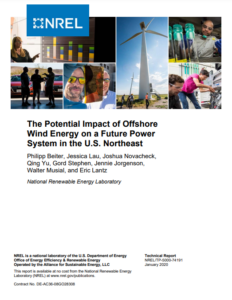Full Title: The Potential Impact of Offshore Wind Energy on a Future Power System in the U.S. Northeast
Author(s): Philipp Beiter, Jessica Lau, Joshua Novacheck, Qing Yu, Gord Stephen, Jennie Jorgenson, Walter Musial, and Eric Lantz
Publisher(s): National Renewable Energy Laboratory
Publication Date: January 26, 2020
Full Text: Download Resource
Description (excerpt):
This study aims to understand and quantify the potential impact of offshore wind energy on a future electricity system in the U.S. Northeast. In this analysis, a detailed representation of the Northeast power system is adopted, using a generation portfolio for 2024 paired with offshore wind nameplate capacities of 0 gigawatts (GW), 2 GW, and 7 GW. The analysis identifies points of offshore wind interconnection in the ISO-New England and New York Independent System Operator control areas and uses hourly wind profiles from the Wind Integration National Dataset Toolkit. Hourly simulations of the 2024 power system operations show an ability to accommodate the prescribed offshore wind capacities by adapting the system’s generation dispatch. Curtailment levels of offshore wind range between 4% and 5%. Offshore wind generation displaces primarily natural-gas combined-cycle generation; however, requires increased flexibility from combined cycles through more frequent start-ups. The number of hours with transmission congestion increases because of offshore wind injection, with varying impact on a subregional level. Offshore wind’s capacity credit was found to be 14.5%−28.3% and is lower than estimated in other large-scale power system studies, in part because this study considered a different weather year and a power system representation with higher shares of solar PV and onshore wind. The reliability contribution of resources is a topic area identified for more research and collaboration. The 7-GW scenario shows a reduction in locational marginal price of 11%, with production cost savings of up to 18% compared to the 0-GW scenario.
